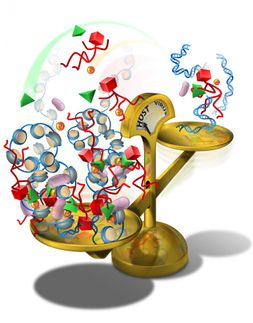DNA repair: Pincer attack
Advertisement
First the scaffold is cracked, then defective parts are removed: Cells repair damaged DNA by a different mechanism than so far assumed, as chemists from Ludwig-Maximilians-Universitaet (LMU) in Munich have shown.
Defects in DNA can cause serious harm to an organism, including cell death or the development of cancer. Efficient repair mechanisms are therefore of vital importance. LMU chemist Professor Christian Ochsenfeld, Chair of Theoretical Chemistry at LMU, and Dr. Keyarash Sadeghian from his group have explained for the first time in detail how a human DNA repair enzyme works. Their computer simulations show that the repair process is different from what was previously thought.
Reactive oxygen species, which arise in every cell as a by-product of respiration, attack DNA. Often, they attack the nucleotide base guanine and oxidize it to a so-called 8OG base. This defect can lead to faulty DNA replication and thus lead to deleterious mutations. The job of DNA repair enzymes is therefore to recognize such bases, bind them in their reactive centres, and remove them from the DNA strand.
"It is really remarkable that even if the undamaged and the damaged guanine are bound in the active centre and assume identical positions, only the oxidized form of guanine is excised from DNA by the human repair enzyme hOGG1", says Sadeghian, first author of the study.
Taking a detour
By running quantum mechanical computer simulations developed in Ochsenfeld's group, the scientists have now managed for the first time to explain how the repair enzyme distinguishes between a normal and an oxidized base. The trick here is that the enzyme takes a detour. "Contrary to the assumptions so far, that the oxidized form of guanine has to be activated first for the repair to take place, we have now shown that the sugar bound to it plays a crucial role in the first step," Sadeghian reports. "The repair enzyme first opens the ring structure of the sugar by gripping it from both sides simultaneously, like a pair of tongs. This step only works if the sugar is bound to the oxidized form of the base. If the normal guanine is bound, then the enzyme is halted and cannot continue its activity." Opening the sugar destabilizes the otherwise highly stable chemical bond between the oxidized nucleotide base and the DNA strand, and the bond is then broken in further steps.
The human repair enzyme hOGG1 is not the only one to follow this clever strategy: A bacterial repair enzyme with a very different structure does so as well, as the scientists have shown. "Our finding that DNA repair enzymes have found a detour and don't attack their target object directly in the first step brings new perspectives for understanding these processes," Ochsenfeld says. "With our computer simulations, we can for the first time follow chemical reactions that occur with such high complexity in nature that they cannot always be captured experimentally. This means we can hopefully clarify in the future whether these DNA repair mechanisms are also used by other enzymes with similar functions.



























































